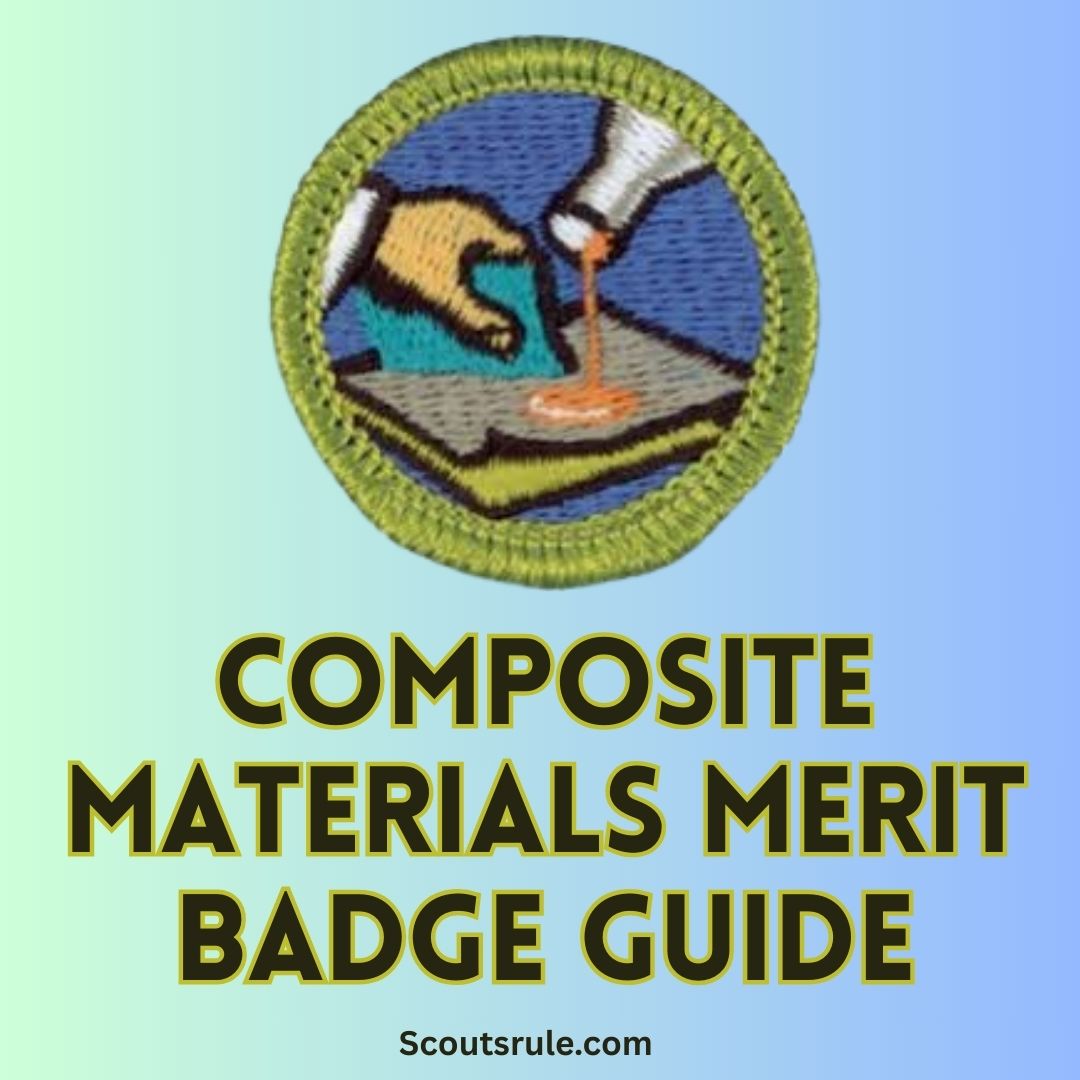
Composite materials have revolutionized modern engineering, offering unique combinations of strength, durability, and light weight. The Composite Materials Merit Badge challenges Scouts to explore the advanced world of engineered materials that yield properties far superior to those of traditional, single-component materials. This badge requires you to learn about the science behind composites, understand safe handling procedures, and even investigate manufacturing techniques and new applications. By earning this badge, you not only gain a solid foundation in materials science but also develop hands-on skills that can steer you toward further studies or careers in engineering, manufacturing, or technology—all while embracing important environmental and safety responsibilities.
Throughout this guide, we will dissect the requirements in detail. We will start by defining composite materials and reviewing their historical evolution. Then, we’ll compare them with conventional materials such as wood and metals, before delving into the critical aspects of safety and handling. Finally, we will cover the manufacturing process, discuss various reinforcement fibers and resins, explore innovative applications, and highlight practical projects and career opportunities. With this comprehensive overview, you will be well on your way to mastering the Composite Materials Merit Badge.
Post Contents
2. Understanding Composite Materials
2.1 Definition and Historical Background
Composite materials are engineered by combining two or more different components to create a material with properties that are superior to those of the individual constituents. Typically, composites consist of two primary elements:
- Reinforcement:
Usually in the form of fibers (such as fiberglass, carbon fiber, or aramid fiber), the reinforcement provides tensile strength and stiffness while being oriented in specific directions to achieve desired properties. - Matrix (Resin):
The matrix is usually a resin (such as epoxy or polyester) that binds the reinforcement together, distributes loads, and protects the fibers from environmental damage.
Historically, humanity has experimented with composite-like materials since ancient times—for example, straw mixed with mud to construct durable bricks or layered wood known as ply. However, significant advances were made during the 20th century, particularly with the aerospace revolution. As engineers sought materials that were both lightweight and incredibly strong, synthetic composites such as fiberglass and carbon fiber became essential. Today, composites are used in a wide range of applications—from the manufacturing of high-performance sports equipment and automobiles to wind turbine blades and even biomedical devices.
2.2 Comparing Composites with Traditional Materials
A crucial element of the merit badge involves comparing composites with traditional materials like wood, aluminum, copper, and steel. Here are several key comparisons:
- Physical Properties:
Density and Weight: Composites are often much lighter than metals, reducing energy consumption in transportation industries. For example, carbon-fiber composites deliver high strength without the added weight of steel or aluminum.
Strength and Stiffness: While metals typically provide isotropic properties (the same in all directions), composites can be engineered to have directional strength, enhancing their stiffness and strength where needed. - Electrical Properties:
Metals such as copper and aluminum are excellent electrical conductors. In contrast, composites are generally insulators and can be an advantage in applications requiring electrical safety. - Corrosion and Chemical Resistance:
Unlike metals, which might rust or corrode over time when exposed to harsh environments, many composites offer excellent resistance against chemicals and moisture, making them ideal for outdoor or corrosive environments. - Mechanical and Thermal Performance:
Composite materials often exhibit high fatigue resistance and can withstand temperature variations better than many traditional materials. However, their performance is highly dependent on the quality of fabrication and the orientation of the reinforcement fibers. - Cost and Manufacturing:
While composites can be costlier in raw material form and require specialized manufacturing techniques, their longevity, light weight, and performance benefits often justify their use in high-performance applications. In contrast, traditional materials might offer lower upfront costs but higher maintenance and life-cycle expenses.
Understanding these comparisons will help elicit why industries ranging from aerospace to automotive and renewable energy are increasingly adopting composite materials.
3. Safety, Handling, and Environmental Responsibility
Safety is paramount when working with composite materials due to the involvement of potentially hazardous chemicals, fine fibers, and curing processes. The merit badge requires you to not only practice safe handling but also to bring awareness to environmental responsibilities.
3.1 Hazards and Precautions
When handling composite materials, several hazards must be considered:
- Chemical Hazards:
Resins and curing agents often contain volatile organic compounds (VOCs) and other chemicals that can be harmful if inhaled or made skin contact. It is essential to handle these substances with care, use proper ventilation, and avoid direct contact. - Fiber Dust and Particulates:
Materials such as fiberglass and carbon fiber can produce fine dust when cut or sanded, which may irritate skin, eyes, or lungs. Always work in a dust-controlled environment or under a fume hood while wearing the proper respiratory protection. - Fire and Thermal Hazards:
Some resins are flammable. Ensure that your workspace is equipped with fire safety measures, and always keep a fire extinguisher nearby. - Handling and Disposal:
Care must be taken when storing and disposing of chemical waste. Improper disposal of composite materials and their byproducts can have a negative environmental impact.
3.2 Personal Protective Equipment (PPE)
To mitigate these hazards, the proper use of Personal Protective Equipment (PPE) is essential. The following gear is recommended whenever you work on composite projects:
- Eye Protection:
Safety glasses or goggles protect eyes from splashes or fiber particles. - Gloves:
Chemical-resistant gloves (often made of nitrile) are crucial when handling resins and curing agents. - Respiratory Protection:
A dust mask or respirator is recommended during sanding or when working in poorly ventilated areas. - Protective Clothing:
Long-sleeved, durable clothing helps avoid skin contact with hazardous materials. - Ventilation:
Work in well-ventilated spaces or use a fume hood to reduce airborne contaminants.
3.3 Material Safety Data Sheets (SDS)
A Material Safety Data Sheet (SDS)—previously well-known as an MSDS—is a key document that outlines the hazards and handling procedures for chemicals such as composite resins and curing agents. The SDS includes vital information about:
- Chemical Properties: Toxicity, flammability, and stability.
- Safe Handling: Recommended PPE, proper storage conditions, and spill cleanup procedures.
- First Aid Measures: Steps to take in case of accidental exposure.
- Disposal Guidelines: How to safely dispose of chemical waste to minimize environmental damage.
Before beginning any composite project, it is critical to consult the relevant SDS documents. This practice ensures your safety and reinforces environmental stewardship as you manage hazardous materials responsibly.
4. Manufacturing Composite Materials
Understanding the manufacturing process is at the heart of the Composite Materials Merit Badge. This section focuses on how composite materials are fabricated, discussing both the reinforcement fibers and the resin matrices used to create these versatile materials.
4.1 Overview of Composite Fabrication
The process of creating a composite generally involves the following steps:
- Layup:
The reinforcement material—such as woven fabric or chopped fibers—is arranged on a mold in a specific orientation to maximize performance in required directions. - Resin Application:
The matrix resin is then applied to saturate the reinforcement. This may be achieved through hand layup, spraying, or using vacuum-assisted resin infusion techniques. The goal is to ensure complete saturation without leaving voids. - Curing:
The composite is subjected to a curing process, which may occur at room temperature or in a heated press/oven. Curing hardens the resin, locking the fiber reinforcement into place and forming a rigid material. - Finishing:
Once cured, the composite part is removed from the mold and undergoes trimming, sanding, or additional finishing processes to achieve the desired dimensions and surface quality.
This process allows manufacturers to craft composite parts with tailored strength, stiffness, and durability, often surpassing the performance of traditional materials for specific applications.
4.2 Composite Reinforcement Materials
A significant component of the badge involves discussing various composite reinforcement fibers. Here are three common types:
- Fiberglass:
- Characteristics: Made from fine glass fibers, fiberglass is relatively inexpensive and widely used. It is lightweight and offers good tensile strength, though its impact resistance can be limited compared to other fibers.
- Applications: Commonly used in boat hulls, automotive body panels, and sporting goods.
- Safety Considerations: Fiberglass particles can irritate the skin and lungs, making effective PPE and proper ventilation critical.
- SDS Usage: Reviewing the SDS for fiberglass materials helps understand safe handling practices, disposal procedures, and any potential chemical hazards.
- Carbon Fiber:
- Characteristics: Known for an exceptional strength-to-weight ratio, carbon fiber is both lightweight and strong, making it ideal for high-performance applications. It is more expensive than fiberglass and can be more brittle under certain loads.
- Applications: Widely used in aerospace components, high-performance automobiles, sports equipment, and even in advanced construction projects.
- Safety Considerations: Carbon fiber dust is hazardous; precise cutting and finishing events require strict use of respirators and protective suits.
- SDS Usage: The SDS for carbon fiber reinforces the need for careful handling, especially during processes that generate airborne particulates.
- Aramid Fiber (e.g., Kevlar®):
- Characteristics: Aramid fibers offer excellent impact resistance, high toughness, and superior heat resistance. Known for their energy absorption properties, they tend to be more flexible than carbon fibers.
- Applications: Commonly found in ballistic armor, racing tires, and advanced composite formulations for automobile and aerospace sectors.
- Safety Considerations: As with the other fibers, protective measures must be in place to prevent skin irritation and respiratory issues when handling aramid fiber dust.
- SDS Usage: Consulting the SDS for aramid fibers informs you on safe handling, proper storage, and disposal techniques.
4.3 Resins Used in Composites
Equally important as reinforcements are the resins that form the matrix. The merit badge requires discussing different types of resins, including thermoset and thermoplastic options:
- Epoxy Resin (Thermoset):
- Characteristics: Epoxy resins are popular due to their excellent adhesion, chemical resistance, and mechanical properties. Once cured, they form a very strong, rigid bond which can be used in demanding applications.
- Applications: Often used in aerospace, automotive, and high-performance sporting equipment where durability is paramount.
- SDS Considerations: Epoxy resins may cause skin sensitization and require extensive handling precautions. The SDS provides guidance on proper ventilation, safe mixing ratios, and disposal measures.
- Innovative Application: An emerging application for epoxy resins might involve developing lightweight, corrosion-resistant composite panels for renewable energy installations such as solar farms or wind turbine housings.
- Polyester Resin (Thermoset):
- Characteristics: Polyester resins are more cost-effective and have faster cure times than epoxies, though they typically offer lower mechanical performance and are more brittle.
- Applications: Common in boat building, shower enclosures, and various consumer products.
- SDS Considerations: Due to their volatile organic compounds (VOC) emissions, polyester resins require good ventilation during application and careful waste disposal.
- Innovative Application: One could consider using polyester resins for affordable, outdoor composite furniture designs or decking solutions where weather resistance and cost efficiency are key factors.
- Thermoplastic Resins:
- Characteristics: Unlike thermoset materials that irreversibly cure, thermoplastic resins can be reheated and remolded. This gives them a potential advantage in recyclability and reusability, while still offering good toughness.
- Applications: Used in automotive parts, consumer electronics, and applications where impact resistance and reprocessing are beneficial.
- SDS Considerations: The SDS for thermoplastics will outline handling precautions related to melting temperatures and surface finish potential hazards.
- Innovative Application: New applications might include creating reconfigurable or adjustable composite structures in consumer products—like modular furniture that can be reshaped as needed without sacrificing structural integrity.
4.4 Innovative Applications and Future Trends
As composite technology evolves, researchers and engineers are continuously seeking novel uses. Some promising areas include:
- Sustainable Construction: Composites that incorporate recycled fibers or bio-based resins could play a significant role in building sustainable structures and reducing environmental footprints.
- Automotive Lightweighting: With a focus on fuel efficiency and electric vehicles, lightweight composite components continue to pave the way for more efficient transportation.
- Aerospace Advancements: New composite formulations that offer increased temperature resistance and reduced weight are crucial for improving the efficiency and safety of modern aircraft and space vehicles.
- Consumer Products: From sporting goods to high-end electronics casings, composites are being tailored to deliver not only performance but also aesthetic appeal.
- Renewable Energy: Composite materials are integral to wind turbine blade manufacturing as well as solar panel supports, where a combination of strength, durability, and light weight is paramount.
Understanding these new applications drives home the point that composite materials aren’t static—they are continuously evolving as technology advances.
5. Practical Projects and Field Experiences
One of the most rewarding aspects of the Composite Materials Merit Badge is the opportunity to engage in hands-on projects. Some Scouts may have the chance to:
- Visit Composite Manufacturing Facilities: Gain firsthand insights into how industries produce advanced composite components. Such visits can provide a tangible understanding of production processes and real-world applications.
- Perform Small-Scale Experiments: Using kits or supervised projects, you might create small composite samples, perform layups, or test the mechanical properties of cured samples.
- Explore Online Composite Resources: Several websites and online tutorials (such as those hosted on Scoutles.com and official BSA pages) provide additional information, videos, and case studies that can deepen your understanding.
- Discussion and Reflection: Document your process, challenges, and observations. Discuss these experiences with your counselor, thereby reinforcing your learning and gaining valuable feedback.
6. Career and Future Opportunities
The skills you develop through the Composite Materials Merit Badge open doors to several high-demand career fields:
- Aerospace Engineering: Professionals in this field rely heavily on composite materials to improve the performance and efficiency of aircraft and spacecraft.
- Automotive Design and Manufacturing: With the push for lighter, more fuel-efficient vehicles, composites are increasingly vital.
- Materials Science and Engineering: Research roles often focus on developing new composites that are stronger, more resilient, and more sustainable.
- Renewable Energy: Industries such as wind and solar power benefit from composites that combine weight reduction with high durability.
- Sports Equipment Manufacturing: Many high-performance sporting goods leverage carbon fiber, fiberglass, or advanced aramid composites for improved performance.
Your exploration of composites through this merit badge can be a stepping stone to advanced education or a career dedicated to solving modern engineering challenges.
Conclusion
The Composite Materials Merit Badge provides an extensive exploration into a field that is as dynamic as it is essential. From understanding the fundamental differences between reinforcement materials and resins, to learning about the critical safety precautions required when working with chemicals and fine fibers, this badge bridges theory and practice. You not only learn the science behind composite materials but also gain hands-on experience through projects that replicate real-world manufacturing processes.

Hi, Robin here, A former lead Scout and here I share my inspiring stories about USA Scouts, leadership, adventure, how to guides and more.






